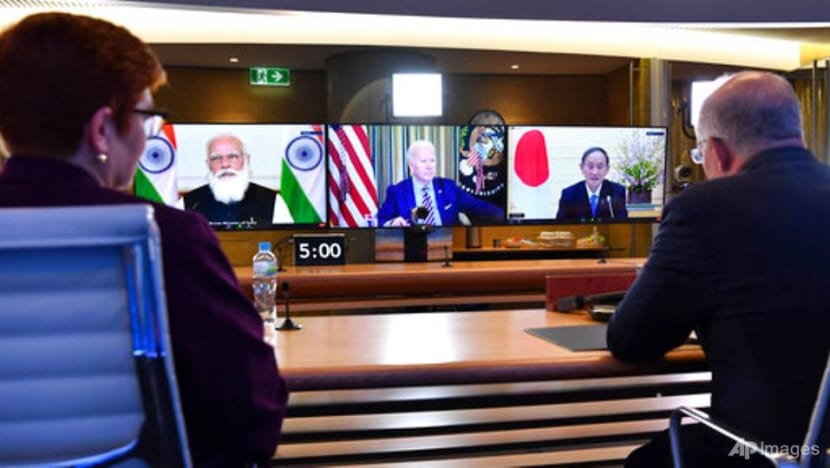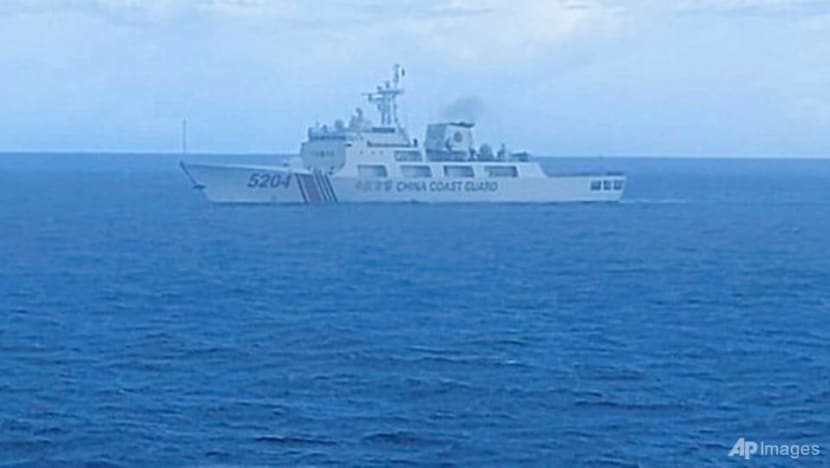commentary Commentary
Commentary: Is China too big to tame? No easy answers to Quad’s central challenge
Countries must confront the dilemma at the heart of the Quad: How to engage China positively while countering its assertive moves, says Charles Hankla.

President Joe Biden just wrapped up the first summit speaking with his counterparts in Japan, Australia, and India. (Photo: AP)
ATLANTA, Georgia: The United States and three of its critical allies in the Asia-Pacific – Japan, Australia, and India – have decided to breathe new life into the long defunct Quadrilateral Security Dialogue, commonly known as the Quad.
The Quad was founded in 2007 to signal to Beijing that the US and its allies would act assertively to counter behaviour seen as a threat to regional security. Tellingly, it went dormant after Australia and India concluded that the organisation risked alienating their most significant economic partner.
But President Donald Trump restarted the Quad in 2017, and in November 2020, after a hiatus of 13 years, it held its largest joint military exercise to date.
More than that, President Joe Biden just wrapped up the first summit of his term speaking with his counterparts in Japan, Australia, and India. This week, following the summit, Biden’s Secretaries of State and Defense are due to make their first international trips not to the Middle East or Europe, but to Japan, South Korea, and India.
READ: Commentary: US must confront China’s assertive, expansionist Asia strategy
That the Quad is back – and that the new US administration is prioritising its relationships in Asia – is surely the clearest sign yet that many major countries in Asia are fearful of China’s expanding influence.
A DILEMMA
America and its Asia-Pacific allies have long seen China as both a threat and an opportunity, but Beijing’s expanding assertiveness has added new urgency to discussions about how to manage its rise.
The problem is that these discussions inevitably brush up against a profound dilemma at the heart of the Quad’s policy towards China: How do you simultaneously nurture a critical economic relationship while deterring behaviour perceived as unfair and indeed threatening? Is China too big to tame?
Over the past two decades, America and its allies have failed to address this dilemma in a coherent fashion. This failure has led to a schizophrenic policy response towards China.
A MOUNTING SENSE OF THREAT
In just the last few months, each of the Quad countries has found itself in a major confrontation with China.

For India, it was last year’s border dispute in remote Ladakh, where Indian and Chinese soldiers skirmished in remote mountain passages. For Japan, it was China’s adoption of a new coast guard law that allows Chinese ships to fire upon vessels in disputed waters. For Australia, it was a trade dispute with China that cost the country at least US$3 billion in exports.
And for the United States, of course, it was the extended Trump trade war, meant to punish China for the full suite of its perceived economic sins, from a failure to protect intellectual property, to currency manipulation and domestic subsidies. To these perceived sins, the new administration can add a massive cyberattack against Microsoft, a major American company.
READ: Commentary: China’s divide-and-conquer strategy isn’t fooling anyone anymore
Longer term issues such as the ongoing disputes in the South China Sea, threats against Taiwan, and the extension of Chinese influence through the Belt and Road Initiative and the Asian Infrastructure Investment Bank, also hover over the relationship.
And, of course, China’s heavy-handed approach to Hong Kong and Tibet and its human rights violations in Xinjiang are also a cause of constant friction.
READ: Commentary: Could 'black hands' be behind the Hong Kong protests?

DEEP INTERDEPENDENCE
The rebirth of the Quad can be understood as pushing back against these policies.
The problem is that, at the same time as the United States and its allies are signaling a more aggressive approach, their economies are only getting more deeply entwined with China’s.
Even for America, whose perch at the top of the world economy looks increasingly precarious, alienating China is a dangerous proposition. This is even truer for relatively smaller Asia-Pacific countries.
China is due to surpass the United States in economic size in 2028, the first time since the late 19th century that America will not rank first. Moreover, China is the largest trading partner of all Quad countries except the United States.
China’s growing heft left the United States under President Barack Obama reluctant to alienate Beijing, particularly in the wake of the 2008 global financial crisis.
More recently, the Trump Administration pulled out of the Trans-Pacific Partnership, which would have allowed America to compete on economics more robustly with China.
READ: Commentary: Is it too late for the US to join the CPTPP?
READ: Commentary: Taiwan is becoming the biggest test in US-China relations
All of this has helped motivate Australia and Japan, along with 12 other countries, to sign the world’s largest regional trade agreement, the Regional Comprehensive Economic Partnership (RCEP) with China in November 2020. India only abstained from the deal due to domestic economic pressure.
A CONFLICTED MESSAGE
The problem with the Quad’s conflicted approach to China is that it sends mixed signals. While it may seem logical to confront Beijing in some areas and to accommodate it in others, for foreign policy signals to work, a clear and consistent message must come through.
So far, the approach of America and its allies to China has been anything but clear and consistent. Signing a massive trade deal while simultaneously holding military exercises aimed specifically at countering China specifically ignores that reality that economic and security policy cannot be separated.
Nor is it not just a case of accommodation in economic affairs and confrontation in security affairs. The United States warred with Beijing in trade from the beginning of the Trump Administration but took a more restrained public approach to the South China Sea until the 2020 election campaign.

With all of this in mind, what should the United States and the Quad do? There are no easy answers, but the goal must be to find a way to channel China’s rise in mutually beneficial ways.
SENDING CLEAR SIGNALS
The last time a rapidly growing power disrupted an international system built around the interests of established powers, it led to two world wars. The deeper interconnectivity between today’s world powers seems to make such a scenario unlikely now, and Beijing appears uninterested in pursuing outright conflict.
But China’s leadership is certainly pushing hard for what it sees as its rights as a new global power, making the possibility of large-scale violence impossible to discount completely.
READ: Commentary: The US’ greatest asset in East Asia may be Japan
Preventing this eventuality while harnessing the benefits of China’s dynamic economy for the world will require a consistent policy approach from the Quad.
Such an approach should not be aggressive nor defensive, and it must avoid empty threats. But it must also set clear boundaries and appreciate the fundamental unity of all instruments of foreign policy.
How would this look in practice? It is critical to maintain a positive relationship with China and never to cut off cooperation, so that disputes can be resolved amicably.
But it is also important to identify clear boundaries that, if crossed, would be met with penalties that are plausible and moderate, but severe enough to deter.
READ: Commentary: Myanmar coup poses first foreign policy test for Biden on Southeast Asia
Because all instruments of foreign policy can be used as signals, crossing an economic boundary could be met with an action in the security arena or vice versa. The same can be said for the Quad’s use of “carrots".
China is rising and will naturally desire more influence, including over the structures of the international system. The policy challenge is to accommodate that rise while protecting the stability of global relationships and the rights of all countries.
The real question is whether such a subtle approach to China can be negotiated among the Quad countries or even sustained within countries across competing interests and parties.
But if the US and its allies want to “reset” the relationship with China, they will have to try.
SIGN UP: For CNA’s Commentary weekly newsletter to explore issues beyond the headlines
Charles R Hankla is an Associate Professor of Political Science at Georgia State University in Atlanta.














